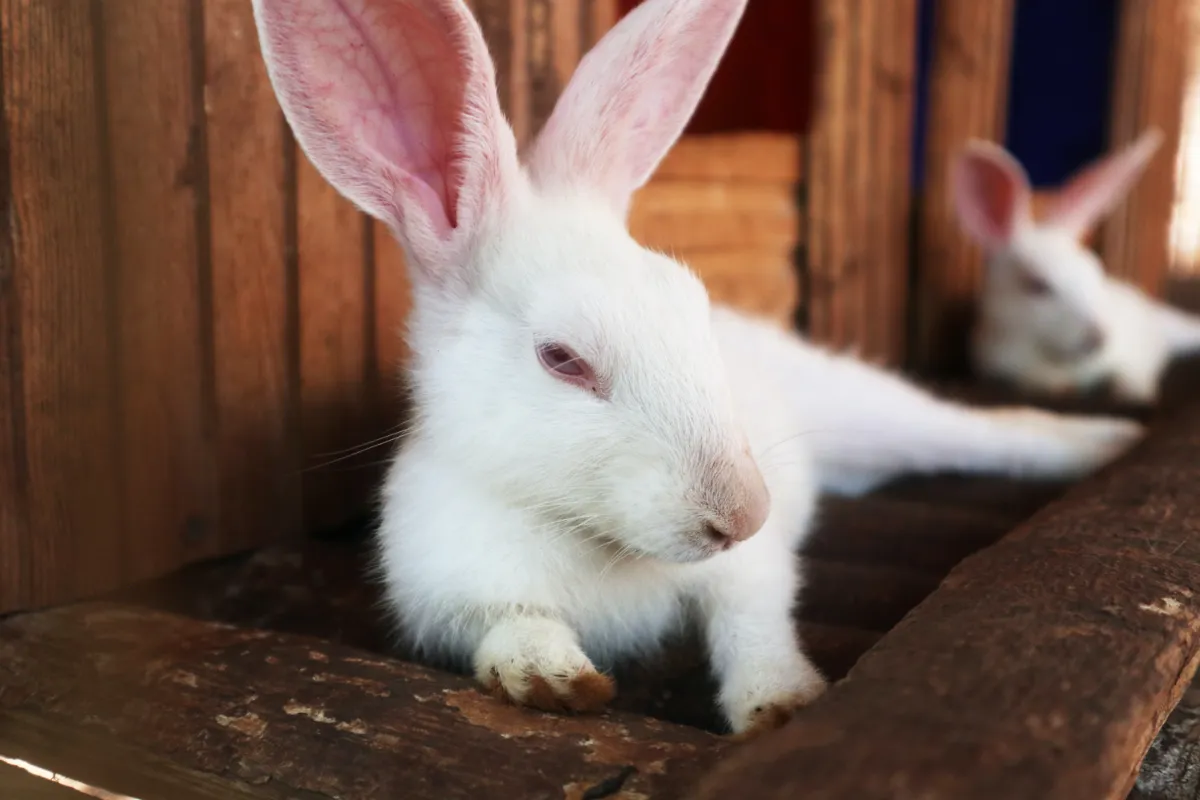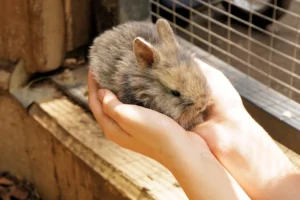Did you know that scruffing a rabbit is a common technique used to handle them? But have you ever wondered if it’s safe or if it causes stress?
In this article, we’ll explore the ins and outs of scruffing rabbits, including why they dislike it and the potential risks involved. We’ll also provide alternatives to gentle handling techniques and tips for building trust with your furry friend.
So, if you’re looking for ways to handle your rabbit without scruffing, keep reading!
In This Article
- 1 Key Takeaways
- 2 The Scruffing Technique: What Is It and How Does It Work With Rabbits
- 3 Understanding Rabbit Behavior: Why Do Rabbits Dislike Being Scruffed
- 4 Potential Risks: Can Scruffing Harm or Stress Out a Rabbit
- 5 Alternatives to Scruffing: Gentle Handling Techniques for Rabbits
- 6 Building Trust: Tips for Bonding With Your Rabbit Without Scruffing
- 7 Handling Fearful Rabbits: How to Approach and Handle Rabbits With Anxiety
- 8 Seeking Professional Advice: Consulting a Rabbit-Savvy Veterinarian or Behaviorist
- 9 Frequently Asked Questions
- 9.1 What Are Some Common Signs of Stress in Rabbits?
- 9.2 Can Rabbits Be Trained to Enjoy Being Handled?
- 9.3 How Do I Know if My Rabbit Is Fearful or Anxious?
- 9.4 Are There Any Specific Handling Techniques That Can Help Calm a Scared Rabbit?
- 9.5 How Can I Find a Rabbit-Savvy Veterinarian or Behaviorist in My Area?
Key Takeaways
- Scruffing should be used with caution and support hindquarters to prevent harm to rabbits.
- Gentle handling alternatives, such as using a soft towel or blanket, can create a cozy and secure environment for rabbits.
- Building trust and a positive relationship with rabbits is important for their well-being.
- Seeking professional advice from rabbit-savvy veterinarians or behaviorists can ensure proper care and address specific concerns or issues.
The Scruffing Technique: What Is It and How Does It Work With Rabbits
Do you know how the scruffing technique actually works with rabbits?
It’s a commonly used method for handling rabbits that involves grasping the loose skin at the back of their neck and lifting them off the ground.
This technique is based on the natural behavior of mother rabbits, who use the scruffing maneuver to carry their young.
When done correctly, scruffing can help to keep the rabbit still and prevent them from struggling or escaping.
It’s important to note that the scruffing technique should be used with caution and only when necessary, as it can cause stress and discomfort for the rabbit.
Always remember to support their hindquarters while scruffing to ensure their safety and well-being.
Understanding Rabbit Behavior: Why Do Rabbits Dislike Being Scruffed
Have you ever wondered why rabbits dislike being scruffed and how it affects their behavior?
Scruffing is a technique commonly used to handle rabbits, especially in situations where aggression needs to be managed. However, it’s important to understand that scruffing can be stressful and uncomfortable for rabbits.
When a rabbit is scruffed, it’s lifted by the loose skin on the back of its neck, resembling how a mother rabbit carries her young. This action triggers an instinctual response in the rabbit, causing it to feel vulnerable and threatened.
As a result, the rabbit may become more aggressive or fearful, leading to negative behaviors such as biting or scratching.
It’s crucial to handle rabbits with care and find alternative methods to manage aggression, such as positive reinforcement training or creating a safe environment for the rabbit to retreat to.
Potential Risks: Can Scruffing Harm or Stress Out a Rabbit
If you scruff a rabbit too harshly or for an extended period of time, it can potentially harm or stress the rabbit out. Scruffing is a common technique used to restrain rabbits, but it should be done with care and caution. The potential long term effects of harsh or prolonged scruffing can have both physical and psychological impacts on rabbits.
- Physical Impact:
- Skin damage: Excessive force during scruffing can cause skin abrasions or even tears.
- Neck strain: Holding a rabbit by the scruff for too long can strain their neck muscles and cause discomfort.
- Respiratory issues: Rabbits may experience difficulty breathing if they’re scruffed too tightly, leading to respiratory problems.
- Psychological Impact:
- Fear and anxiety: Rough scruffing can traumatize rabbits and make them fearful of human interaction.
- Trust issues: Rabbits may develop trust issues and become hesitant to interact with their owners or other humans.
- Behavioral changes: Prolonged stress from scruffing can lead to changes in behavior, such as aggression or withdrawal.
It is important to handle rabbits gently and to avoid excessive scruffing to prevent these potential negative effects.
Alternatives to Scruffing: Gentle Handling Techniques for Rabbits
You can try using a soft towel or blanket instead of scruffing to handle your rabbit gently.
Scruffing, which involves firmly grasping the loose skin on the back of a rabbit’s neck, is a controversial method of restraint that can cause stress and discomfort for your furry friend.
By using a soft towel or blanket, you can create a cozy and secure environment for your rabbit, allowing for gentle handling without the need for forceful restraint.
This alternative approach promotes positive reinforcement and a trusting relationship between you and your rabbit.
Remember to approach your rabbit calmly and slowly, and always reward them with treats or praise for their cooperation.
Building Trust: Tips for Bonding With Your Rabbit Without Scruffing
Using patience and consistency, you can gradually build trust with your rabbit by implementing gentle bonding techniques that don’t involve scruffing. Building trust with your rabbit is essential for creating a positive and loving relationship. Here are some tips to help you in this process:
- Spend quality time with your rabbit every day. This will allow you to bond and establish a sense of security.
- Use positive reinforcement techniques, such as offering treats and praise when your rabbit displays desired behaviors. This will help them associate you with positive experiences.
- Respect your rabbit’s boundaries and body language. Pay attention to their signals and avoid forcing interactions.
Handling Fearful Rabbits: How to Approach and Handle Rabbits With Anxiety
Certainly, when handling fearful rabbits, it’s important to approach them gently and with patience. Rabbits can be easily scared and may exhibit aggressive behavior when they feel threatened. To handle aggressive rabbits, it’s crucial to gain their trust and create a calm environment.
Start by introducing yourself slowly, speaking softly and avoiding sudden movements. Offer treats and let the rabbit come to you at its own pace. When picking up the rabbit, support its body and hindquarters, ensuring it feels secure. Avoid scruffing, as it may increase fear and stress.
When introducing rabbits to new environments, provide a safe and quiet space for them to explore. Gradually introduce them to new smells and sounds, allowing them to adjust at their own pace. By handling fearful rabbits with care and patience, you can help them feel safe and secure in their surroundings.
Seeking Professional Advice: Consulting a Rabbit-Savvy Veterinarian or Behaviorist
If you’re considering seeking professional advice for your rabbit, it’s important to consult a rabbit-savvy veterinarian or behaviorist. These experts have the knowledge and experience to provide you with the best guidance for your furry friend.
When seeking advice, it can also be beneficial to seek second opinions. Different professionals may have different perspectives and approaches, so getting multiple viewpoints can help you make well-informed decisions for your rabbit’s health and well-being.
Additionally, one important aspect to consider is the benefits of positive reinforcement training. This training method focuses on rewarding desired behaviors rather than punishing unwanted behaviors. It can help improve your rabbit’s behavior and strengthen the bond between you and your pet.
Seeking professional advice and incorporating positive reinforcement training can greatly enhance the quality of life for your rabbit.
Frequently Asked Questions
What Are Some Common Signs of Stress in Rabbits?
Common signs of stress in rabbits include excessive grooming, loss of appetite, aggression, and hiding. To reduce stress, provide a safe and comfortable environment, regular exercise, proper diet, and social interaction.
Can Rabbits Be Trained to Enjoy Being Handled?
Training rabbits to enjoy being handled is possible. By understanding rabbit behavior and using positive reinforcement techniques, you can build trust and create pleasant experiences. Remember, Rome wasn’t built in a day!
How Do I Know if My Rabbit Is Fearful or Anxious?
To understand if your rabbit is fearful or anxious, observe their body language. Signs may include hiding, thumping, or excessive grooming. Create a safe and comfortable environment by providing hiding spots, regular exercise, and gentle handling.
Are There Any Specific Handling Techniques That Can Help Calm a Scared Rabbit?
To calm a scared rabbit and reduce their stress, there are specific handling techniques you can use. These techniques focus on creating a safe and secure environment, providing gentle touch, and using positive reinforcement to build trust and confidence.
How Can I Find a Rabbit-Savvy Veterinarian or Behaviorist in My Area?
Looking for a rabbit-savvy vet or behaviorist in your area? Start by checking online directories, contacting local rabbit rescues, or asking fellow rabbit owners for recommendations. They can help you find the rabbit experts near you.





